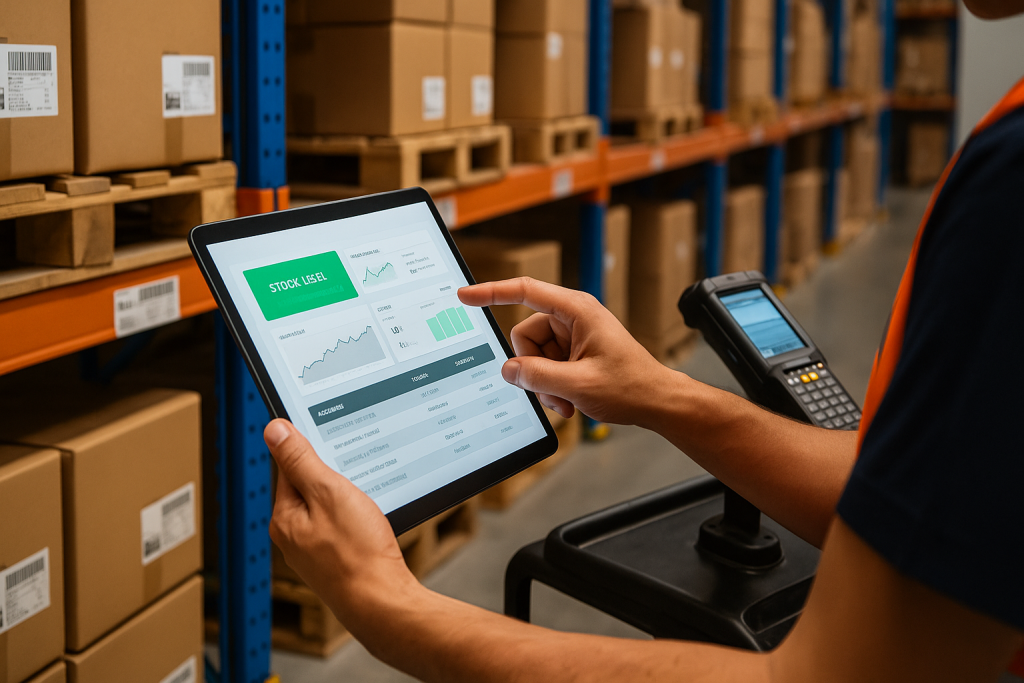By Martin Vassilev / 29 Oct, 2025
In today’s fast-moving logistics landscape, real-time inventory management has become a necessity rather than a competitive advantage. Gone are the days when warehouses could rely on periodic updates or manual stock counts. With global supply chains becoming more complex and customer expectations for same-day or next-day delivery soaring, logistics companies must adopt real-time visibility solutions to stay efficient, reduce costs, and deliver unmatched service.
Traditional inventory systems rely on static data — daily or weekly updates — leaving operations vulnerable to discrepancies. A product might appear in stock when it’s actually out of reach, leading to shipping delays, dissatisfied customers, and increased carrying costs. In high-volume fulfillment environments, these lags create inefficiencies that ripple throughout the entire supply chain.
Real-time inventory tracking provides instant updates across all nodes of the supply chain — from warehouse shelves to delivery trucks. By integrating technologies like RFID, IoT sensors, and AI-driven analytics, logistics companies gain up-to-the-second insights into stock levels, movement patterns, and potential bottlenecks.
When integrated with systems like AI-powered logistics solutions, companies can predict shortages, automate restocking, and ensure seamless order fulfillment across multiple regions.
Having access to live inventory data helps logistics managers anticipate disruptions before they happen. Real-time systems can instantly detect low stock levels, damaged goods, or delayed shipments, allowing teams to take corrective action immediately. According to a study by the U.S. Department of Commerce, over 70% of logistics inefficiencies stem from delayed or inaccurate data reporting.
In the age of Amazon-like speed, customers expect precision and transparency. Real-time tracking enables instant order status updates, accurate delivery timelines, and proactive issue resolution. This technology not only boosts customer trust but also helps logistics companies secure repeat business.
Manual checks and outdated systems are expensive. Automation through real-time tools minimizes human error, overstocking, and understocking, directly improving the bottom line. Companies using real-time inventory management report up to 25% reductions in warehousing costs, as detailed in this guide to reducing warehousing costs.
For companies managing multiple fulfillment centers — like ByExpress’s network across Ottawa, Toronto, and Calgary — real-time systems unify data from all locations into a single dashboard. This eliminates siloed communication and improves order routing based on proximity, availability, and efficiency.
Real-time data empowers logistics leaders to make strategic decisions based on facts, not estimates. Through predictive analytics and trend visualization, businesses can forecast demand more accurately, optimize routes, and maintain perfect inventory balance.
The Internet of Things (IoT) and Radio Frequency Identification (RFID) have transformed logistics by enabling asset-level visibility. RFID tags embedded in pallets or containers continuously send data on movement and condition. Combined with IoT sensors, companies can monitor temperature, humidity, and vibration levels, ensuring the safe transport of sensitive goods like pharmaceuticals or perishables.
AI algorithms detect inefficiencies and suggest optimizations in real-time. From predicting which items will sell fastest to recommending ideal stock levels per location, AI-driven insights streamline logistics operations. ByExpress’s integration of AI in warehouse management demonstrates how technology enables smarter decisions with less human intervention.
Modern cloud-based WMS platforms allow 24/7 remote access to inventory data from any device. This not only increases flexibility but also strengthens coordination between suppliers, carriers, and warehouse operators. Scalability is another advantage — as your logistics network grows, your system can expand effortlessly.
Blockchain’s immutable ledger guarantees data integrity throughout the supply chain. When integrated into real-time systems, it ensures all stakeholders — from suppliers to end customers — can verify product movement and authenticity, supporting compliance and trust. Learn more about its impact in the role of blockchain technology in logistics.

Instead of relying on static reorder points, real-time systems dynamically trigger restock orders when inventory dips below thresholds. This ensures uninterrupted operations and reduces carrying costs.
Real-time analytics capture consumer trends and seasonal fluctuations. When combined with data analytics strategies, logistics companies can proactively plan inventory allocation and avoid both overstocking and lost sales.
Live updates mean warehouse teams always know the exact location of every SKU. Automated picking systems can access the latest data to select, pack, and dispatch goods faster — directly improving fulfillment speed and accuracy.
When data flows seamlessly between manufacturers, distributors, and retailers, inefficiencies vanish. Real-time inventory tools enable end-to-end visibility, fostering collaboration and trust across global supply chains.
ByExpress exemplifies how logistics companies can adopt real-time visibility to enhance customer experience and operational precision. By synchronizing data between warehouses, delivery fleets, and online portals, they ensure accurate stock availability and instant shipment updates. This commitment to technology-driven transparency has positioned them as a leader in Canadian logistics efficiency.
Their investment in AI and automation has not only improved response times but also allowed businesses using ByExpress to reduce inventory discrepancies and optimize storage utilization. For clients operating in fast-paced markets like Ottawa, Toronto, and Calgary, these real-time capabilities are indispensable.
Many logistics companies rely on legacy ERP or WMS systems that were never designed for real-time data synchronization. Upgrading these systems can require significant capital investment and technical expertise.
As real-time systems depend on constant data flow, they become prime targets for cyber threats. Companies must prioritize robust cybersecurity protocols, including encryption and access control, to safeguard operational integrity.
Implementing new technologies requires retraining staff and redefining workflows. Resistance to change can slow adoption — a challenge that can be mitigated by clear communication and leadership commitment.
Assess Current Systems: Identify gaps in visibility and areas of manual dependency.
Choose the Right WMS: Opt for a cloud-based platform with API integrations that support IoT and AI tools.
Integrate Data Sources: Connect supplier, warehouse, and delivery data streams into a unified dashboard.
Train Your Workforce: Equip staff with the skills to interpret live analytics and leverage automation.
Monitor and Refine: Continuously evaluate system performance using logistics KPIs.
Compliance is a critical component of logistics operations. Real-time tracking helps ensure adherence to government regulations such as Canada’s Transport Dangerous Goods Act and U.S. FDA Food Safety Modernization Act (FSMA). You can explore detailed compliance guidelines through Transport Canada’s logistics standards and U.S. Customs and Border Protection.
As logistics evolves, predictive inventory management powered by AI and automation will redefine the industry. Systems will not only display what’s happening now but also forecast what’s coming next. Autonomous warehouses and self-learning logistics networks are already emerging trends — as explored in the future of warehouse automation.
Real-time management is just the first step toward a fully connected logistics ecosystem where every shipment, shelf, and sensor communicates continuously — driving cost savings, agility, and customer loyalty.
It’s a system that provides continuous visibility into stock levels, movements, and availability across the supply chain using technologies like RFID, IoT, and AI.
Real-time tracking prevents stockouts, improves order accuracy, and enables faster decision-making, directly enhancing profitability and customer satisfaction.
Key tools include IoT sensors, RFID tags, AI analytics, cloud-based WMS platforms, and blockchain for data transparency.
It minimizes errors, optimizes space utilization, and automates replenishment — all of which significantly reduce operational expenses.
Start by auditing your current system, selecting an integrated WMS, and partnering with a logistics provider like ByExpress that offers end-to-end automation and tracking solutions.
Real-time inventory management is not a luxury — it’s a survival tool for modern logistics. As supply chains grow increasingly complex and customer expectations rise, the companies that embrace live data, automation, and predictive intelligence will lead the market. Those that don’t risk being left behind in a world where speed, transparency, and accuracy define success.

“Thanks to Byexpress all my shipping and fulfillment costs are in line now”

“All my issues were solved by Byexpress team that I had with pervious 3pl provider.”

“Thank you Byexpress team could not done it without you guys.”

“Their integration and customer service were the key for me”

“Outstanding delivery service! The package was well-packaged, and
the delivery team was professional and courteous”

“Great and knowledgeable team to work with.”

Thanks, guys, for reducing my shipping rates
Ottawa Office
2411 Holly Lane
Ottawa, ON, K1V 7P2
Toronto Office
13-280 West Beaver Creek Road Unit #136
Richmond Hill, ON, L4B 3Z1
Alexandria Office
173 Kenyon Street West
Alexandria, ON, K0C 1A0
Montreal Office
4388 Saint-Denis Street Unit #200
Montreal, QC, H2J 2L1
California Office
155 North Riverview Drive
Anaheim Hills, CA, 92808
Call Us
Toll-Free: 1-866-744-7122
Local : 613-739-3000
Email Us
Multilingual Services










